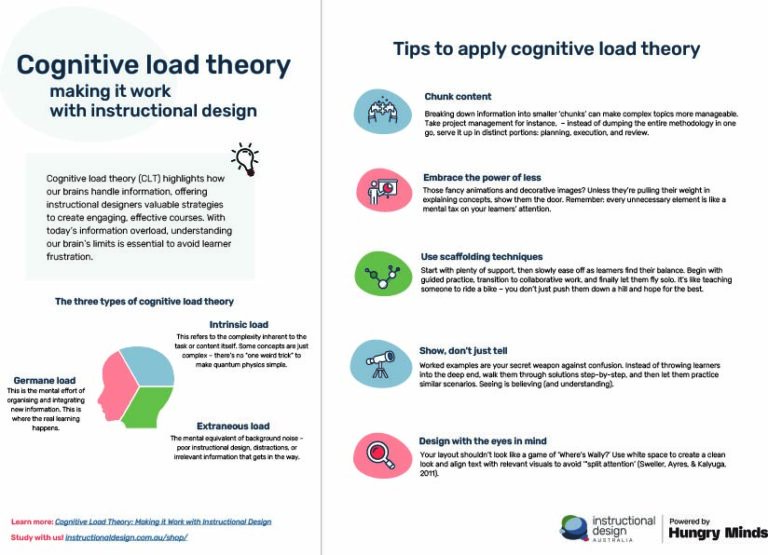Cognitive Load Theory: Making it Work with Instructional Design
FREE download
Complete the form to download a quick reference guide (QRG) for creating effective learning outcomes using Cognitive Load Theory.

Ever wondered why some training feels like a breeze while other courses leave you mentally exhausted? The answer isn’t in your coffee intake – it’s in your brain’s processing power. Cognitive Load Theory (CLT) offers a fascinating look at how our brains process information, giving us instructional designers insights on how to create more engaging and effective courses for our learners. In today’s landscape of constant information bombardment, learning designers are finally catching on to what neuroscience has been telling us all along: our brains have bandwidth limits, and exceeding them is a recipe for frustration.
Join us as we unpack what CLT is, discover why it’s transforming learning design, and explore practical ways you can apply it.
What is Cognitive Load Theory?
The premise is refreshingly simple: our working memory has limits. John Sweller figured this out in the late 1980s when he developed Cognitive Load Theory (CLT), proving what students everywhere had long suspected – there really is such a thing as “too much information.” CLT breaks down cognitive load into three distinct types:
- Intrinsic Load – This refers to the complexity inherent to the task or content itself. Some concepts are just complex – there’s no “one weird trick” to make quantum physics simple.
- Extraneous Load – The mental equivalent of background noise – poor instructional design, distractions, or irrelevant information that gets in the way.
- Germane Load – This is the mental effort of organising and integrating new information. This is where the real learning happens.
In essence, CLT helps you design courses that respect the learner’s cognitive limits, reducing frustration and maximising learning potential (Sweller, 1988).
Cognitive Learning Theory in Instructional Design
Here’s where things get interesting. CLT’s transforms instructional design, allowing you to:
- Keep Minds Clear – By managing cognitive load, you help learners process information without feeling overwhelmed.
- Make Learning Last – When learners have the cognitive space to process information, it actually sticks.
- Maintain Focus – Reducing extraneous load keeps learners focused on the content, fostering deeper engagement with the material.
When you design with CLT in mind, you create a smooth learning journey where learners feel empowered rather than bogged down, respecting both the content and the learner.
Practical Tips for Making Cognitive Load Theory Work
Here are some CLT strategies you can use to support your learning content to make them more digestible for your learners:
- Chunk Content – Breaking down information into smaller ‘chunks’ can make complex topics more manageable. Take project management for instance, – instead of dumping the entire methodology in one go, serve it up in distinct portions: planning, execution, and review.
- Embrace the Power of Less – Channel your inner minimalist and strip away anything that doesn’t directly support the learning objectives. Those fancy animations and decorative images? Unless they’re pulling their weight in explaining concepts, show them the door. Remember: every unnecessary element is like a mental tax on your learners’ attention.
- Use Scaffolding Techniques – This is the scaffolding training wheels for the mind. Start with plenty of support, then slowly ease off as learners find their balance. Begin with guided practice, transition to collaborative work, and finally let them fly solo. It’s like teaching someone to ride a bike – you don’t just push them down a hill and hope for the best.
- Show, Don’t Just Tell – Worked examples are your secret weapon against confusion. Instead of throwing learners into the deep end, walk them through solutions step-by-step, and then let them practice similar scenarios. Seeing is believing (and understanding).
- Design with the Eyes in Mind – Your layout shouldn’t look like a game of ‘Where’s Wally?’ Use white space to create a clean look and align text with relevant visuals to avoid ‘“split attention’ (Sweller, Ayres, & Kalyuga, 2011).
Tips for Making Cognitive Load Theory Work for You
- Start Simple – Before diving into complex theories or methods, introduce basic concepts that will help learners build foundational knowledge.
- Use Interactive Elements Wisely – Interactive elements can be beneficial but may also add to the cognitive load. Use them strategically to enhance learning, not distract.
- Encourage Reflection – Regularly prompt learners to pause and reflect on what they’ve learned. Reflection aids in integrating information into long-term memory.
- Feedback Loops – Immediate feedback helps learners correct mistakes before they become ingrained, which is crucial for managing cognitive load.
Final Thoughts
Cognitive Load Theory provides a roadmap to creating content that respects the limits of working memory, navigating the fine line between the fine line between challenging learners and overwhelming them. By integrating CLT into your practice, you’re designing learning experiences that resonate rather than frustrate. So next time you start a new project, keep CLT in mind and give your learners the gift of a smoother, more effective learning journey.
References
Sweller, J. (1988). Cognitive load during problem solving: Effects on learning. Cognitive Science, 12(2), 257-285.
Sweller, J., Ayres, P., & Kalyuga, S. (2011). Cognitive load theory. Springer Science & Business Media.
